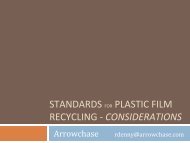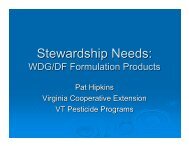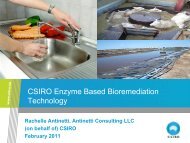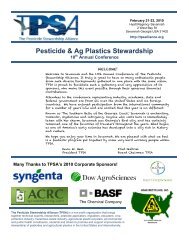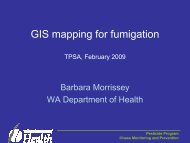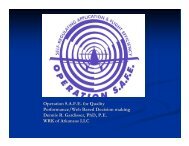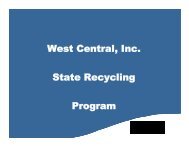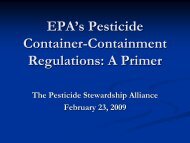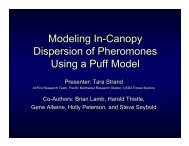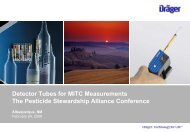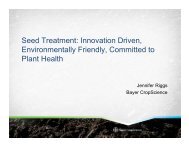Clean Sweep Programs - US Environmental Protection Agency
Clean Sweep Programs - US Environmental Protection Agency
Clean Sweep Programs - US Environmental Protection Agency
- No tags were found...
Create successful ePaper yourself
Turn your PDF publications into a flip-book with our unique Google optimized e-Paper software.
The <strong>Clean</strong> <strong>Sweep</strong> ReportOther grants: Texas has successfully garneredfunds and partnerships from state agencies andprivate organizations including the South TexasAgricultural Chemical Association, the ACRC, theTexasAgricultural Extension Service, the TexasDepartment of Agriculture, and local environmentalgroups. Alabama and Mississippi have receivedgrants from the Tennessee Valley Authority for theirprograms.Figure 3 Ohio Funding SourcesState-based fundsEPA grants2.3 To what extent has EPA providedfunding to <strong>Clean</strong> <strong>Sweep</strong> programs?EPA has funded only a small percentage ofthe total cost of <strong>Clean</strong> <strong>Sweep</strong> programs. Sincedetailed cost and funding data for every state’s<strong>Clean</strong> <strong>Sweep</strong> program are not available, it is notpossible to provide the total amount and proportionof EPA funding. However, information on Ohio’sfunding is available and is typical of other states.From 1993 through 2000, Ohio spent more than$1.5 million to collect and dispose of over onemillion pounds of pesticides. With the exception of$80,000 received from EPA under the Coastal<strong>Environmental</strong> Management Program for collectionsin Lake Erie counties, the Ohio Department ofAgriculture has paid all program costs. The majorityof the project funding was generated from statepesticide registration fees and the EPA grantcomprised less than 6 percent of Ohio’s totalfunding, as shown in Figure 3.The limited EPA funds used to support stateand locally run <strong>Clean</strong> <strong>Sweep</strong> programs generally fallinto one or more of the following general categories.Providing Seed Money. In several cases, EPA hasfunded pilot projects, which were intended todemonstrate the necessity and effectiveness of <strong>Clean</strong><strong>Sweep</strong> programs to government officials and thepublic. An EPA grant of $75,000 under the <strong>Clean</strong>Water Act for a pilot project was coupled withState-based funds (mainly pesticide reg. fees):$1,420,000 (94.4%)EPA grants: $80,000 (5.6%)Colorado’s commitment of a $50,000 in-kind matchto fund the state’s first <strong>Clean</strong> <strong>Sweep</strong> in 1995. Sincethen, participant fees have funded three years ofcollections in Colorado. Similarly, Georgia receivedan EPA grant in 1993 of $48,000 for a pilotcollection, and a second grant of $40,000 for a1996 collection. These events were so successfulthat the Georgia Department of Natural Resourcesprovided a solid waste grant of $50,000 to conductthe 1997 collection. State funds have fundedsubsequent collections and the Georgia GeneralAssembly plans to allocate up to a total of $2.5million. Maryland’s <strong>Clean</strong> <strong>Sweep</strong> program began in1995 with an EPA grant of $75,000 and state fundscarried the program through 1999. EPA’s Region 5provided seed money for <strong>Clean</strong> <strong>Sweep</strong> programs inthe late 1980’s, and now most of the Region 5 states– Michigan, Minnesota, Ohio, and Wisconsin –have programs that are funded through statepesticide registration fees.Satisfying Criteria in Cooperative Agreements.FIFRA gives EPA authority to enter into cooperativeagreements with and to provide grants to states toimplement federal pesticide regulatory requirements.15



